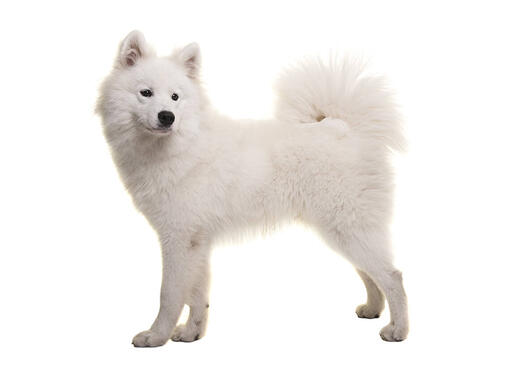
An ancient Siberian sledge dog bred to herd and guard reindeer,, the Samoyed is characterized by his hefty, weather-resistant coat and signature smiling black lips. This working breed thrives on having a job to do. A perfect companion for families with children, he is kind, gentle and devoted. The highly intelligent, active Samoyed needs daily exercise and will retain his puppy-like playfulness throughout his lifetime.
DID YOU KNOW? A team of Samoyeds accompanied Norwegian explorer Roald Amundsen on his quest to discover the South Pole in 1911. The Samoyed’s gene pool contains no wolf or fox blood, distinguishing this dog as a primitive breed.
ALSO KNOWN AS: Bjelkier, Samoiedskaya Sobaka, Nenetskaya Laika
The need-to-know
- Dog suitable for owners with some experience
- Some training required
- Enjoys vigorous walks
- Enjoys walking one to two hours a day
- Medium dog
- Heavy drool
- Requires grooming daily
- Non hypoallergenic breed
- Chatty and vocal dog
- Guard dog. Barks and alerts
- May require training to live with other pets
- Great family dog
Personality

The Samoyed is generally a friendly, outgoing and devoted dog. Samoyeds are protective of their homes. No intruder will ever go unheard, although they rarely do much more than announce their presence. He loves to be included in all family activities and can become destructive and vocal if left for too long or bored. They enjoy digging and are great escape artists, so garden security is essential. They have to be socialised from an early age, especially with cats and any other household pets. They can be quite vocal.
History and Origins

Country of Origin: Russia
Known at various times as the Smiling Dog or the Reindeer Dog, the Samoyed is an ancient reindeer-herding dog who takes their now universally known name from the tribe that treasured it so highly and worked alongside it - the Samoyede people of Northern Siberia.While largely a herding dog, the Samoyed (or Sami) was a multi-purpose dog who would not only control livestock but would also pull sledges, and on occasions, provided the tribe with fur garments to keep them warm in the most inhospitable of climates.
Nutrition and Feeding

Large breed dogs, as well as having large appetites, benefit from a different balance of nutrients including minerals and vitamins compared to smaller-breed dogs. Samoyeds can be prone to bloating and stomach problems. Smaller, more frequent meals can help minimise this risk.
Exercise

The Samoyed dog breed needs a reasonable amount of dog exercise both on and off the lead. They do have a natural tendency to pull on a lead; however, they can be trained to walk beside you, or a headcollar can be used. An adult Samoyed needs a couple of hours of exercise daily, but his thick coat means he can easily over-heat and so very early morning exercise is ideal.
Ideal Owner

The Samoyed would suit an owner or a family who wants a friendly happy dog, who are at home most of the time, who prefer a non-heated house and don’t mind being covered in white hair!
Other Information

Health and common issues
The main inherited disease that the Samoyed suffers from is a particular type of kidney disease. As with many breeds, they can also suffer from various hereditary eye disorders, and hip dysplasia (a condition that can lead to mobility problems). Eye testing and hip scoring of dogs prior to breeding is therefore important.
Training samoyeds
The Samoyed isn’t ever going to be an obedience champion as formal training isn’t in his repertoire! What he loves to do is run - so if you can find a club who specialises in Canicross, your Sami will be in heaven. If not, long lead walks will be in order after you've spent some time training him not to pull. After all, that’s what they were bred for!
Best family dog breeds
Samoyeds make great family dogs as they enjoy being involved in everything and have happy, patient personalities. While many dogs are traditionally thought of as being good with children, all dogs and children need to be taught to get on with and respect each other, and be safe together. Even so, dogs and young children should never be left alone together and adults should supervise all interactions between them.
Did you know?
- The Samoyed dog takes its name from the Samoyedic peoples of Siberia. These nomadic reindeer herders bred the fluffy, white, smiling dogs to help with the herding, to pull sleds, and to keep their owners warm at night by sleeping on top of them.
- As Samoyeds were the easiest of the Arctic dogs to buy at the end of the 19th century, early polar explorers such as Shakleton and Scott used them as sledge dogs on their historic expeditions. Once such dog, called Antarctic Buck ended up in Sydney Zoo being exhibited between two tigers before being discovered and shipped back to England to join the breed’s foundation stock there.
- Recent DNA analysis of the breed has discovered that they are one of the oldest dog breeds.